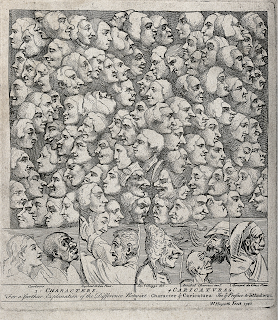JDB als karikaturist
`
“Kluyskens noemt als voorbeelden Leonardo da Vinci en Annibale Carracci in Italië, William Hogarth in Engeland, Gavarni, Granville en speciaal Daumier in Frankrijk, en in eigen land James Ensor en “vooral de grote Jules De Bruycker”, die allebei - voegt hij daaraan toe - “wereldfaam hebben verkregen”. (Huys).
JDB aanvaardde het etiket ‘karikatuur’ niet.
Hij interpreteerde het als een verwijt en las het als ‘slechts een karikaturist”.
Dit ongenoegen over zo’n typering vinden we terug bij William Hogarth die er zelf een werk aan wijdde: Characters and Caricatures. Ook Hogarth was verbolgen over het feit dat critici hem beschreven als: “a mere ‘caricature’ artist”.
William Hogarth (1697-1764)
“For Hogarth the comic character face, with its subtle exploration of an individual's human nature, was vastly superior to the gross formal exaggerations of the grotesque caricature"
He later had this to say about his motivations behind the print:
`
“Kluyskens noemt als voorbeelden Leonardo da Vinci en Annibale Carracci in Italië, William Hogarth in Engeland, Gavarni, Granville en speciaal Daumier in Frankrijk, en in eigen land James Ensor en “vooral de grote Jules De Bruycker”, die allebei - voegt hij daaraan toe - “wereldfaam hebben verkregen”. (Huys).
Hij interpreteerde het als een verwijt en las het als ‘slechts een karikaturist”.
Dit ongenoegen over zo’n typering vinden we terug bij William Hogarth die er zelf een werk aan wijdde: Characters and Caricatures. Ook Hogarth was verbolgen over het feit dat critici hem beschreven als: “a mere ‘caricature’ artist”.
William Hogarth (1697-1764)
“For Hogarth the comic character face, with its subtle exploration of an individual's human nature, was vastly superior to the gross formal exaggerations of the grotesque caricature"
He later had this to say about his motivations behind the print:
“Being perpetually plagued, from the mistakes made among the illiterate, by the similitude in the sound of the words Character and Caricatura, I ten years ago endeavoured to explain the distinction by the above Print; and, as I was then publishing Marriage a la Mode, wherein were characters of high life, I introduced the great number of faces there delineated (none of which are exaggerated) varied at random, to prevent, if possible, personal application when the Prints should come out...”
“He who should call the Ingenious Hogarth a Burlesque Painter, would, in my Opinion, do him very little Honour; for sure it is much easier, much less the Subject of Admiration, to paint a Man with a Nose, or any other Feature of a preposterous Size, or to expose him in some absurd or monstrous Attitude, than to express the Affections of Men on Canvas. It hath been thought a vast Commendation of a Painter, to say his Figures seem to breathe; but surely, it is a much greater and nobler Applause, that they appear to think.”
Along the bottom of the print, to the left, Hogarth has reproduced three character figures from the works of Raphael, a style with which he clearly identifies. To the right sit four caricatures: a head copied from Arthur Pond's Caricatures; heads from Annibale Carracci's Due Filosofi; and (perhaps rather unfairly) a Leonardo da Vinci grotesque reproduced from Têtes de Charactêres — and floating above the first and second of these caricatures a child-like cartoon, as if to emphasise the naivety of such a style. Above the strip, in a wonderfully overwhelming swarm of heads which take up the vast majority of the print, Hogarth has drawn over a hundred faces in a style much closer to the "characters" of Raphael.
At the very bottom he's provided a note on some helpful further reading: "For a farthar Explanation of the Difference Betwixt Character & Caricature See ye Preface to Joh. Andrews." Here he refers to his friend Henry Fielding's 1742 work Joseph Andrews, in which Fielding calls himself a "Comic Writer" and Hogarth a "Comic Painter" — both aligned with a sensitive realism associated with depicting character, as opposed to the crude distortion of caricatures (which Fielding aligns with the "burlesque").
Bron: Characters and Caricaturas by William Hogarth (1743) – The Public Domain Review
https://publicdomainreview.org/collection/characters-and-caricaturas-by-william-hogarth-1743
At the very bottom he's provided a note on some helpful further reading: "For a farthar Explanation of the Difference Betwixt Character & Caricature See ye Preface to Joh. Andrews." Here he refers to his friend Henry Fielding's 1742 work Joseph Andrews, in which Fielding calls himself a "Comic Writer" and Hogarth a "Comic Painter" — both aligned with a sensitive realism associated with depicting character, as opposed to the crude distortion of caricatures (which Fielding aligns with the "burlesque").
Bron: Characters and Caricaturas by William Hogarth (1743) – The Public Domain Review
https://publicdomainreview.org/collection/characters-and-caricaturas-by-william-hogarth-1743
Hogarth's London - Workshop at Royal Drawing School West in London
https://www.artrabbit.com/events/hogarths-london
This course will study Hogarth's vision as a portraitist, caricaturist, engraver, moralist, raconteur and flâneur.
"Hogarth reveals that good painting can be witty: a discovery made suitably enough only in the age of wit." Michael Levey, 1962
Hogarth was an extraordinary artist, remembered chiefly as a satirist but with a wickedly humorous eye. He was equally engaged in aesthetics as in politics, a keen observer of people and society at all levels. This course will study his vision as a portraitist, caricaturist, engraver, moralist, raconteur and flâneur. In museums and galleries including The National Gallery, Tate and Chiswick House, we will draw from Hogarth’s paintings, studying in particular his developing interest in how human behaviour can be best displayed. As well as drawing from his work in these London collections, we will also draw in contemporary urban settings, creating a rich fusion of art history, methodology and observational drawing.




Geen opmerkingen:
Een reactie posten